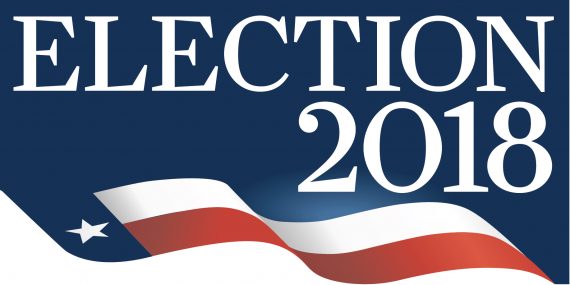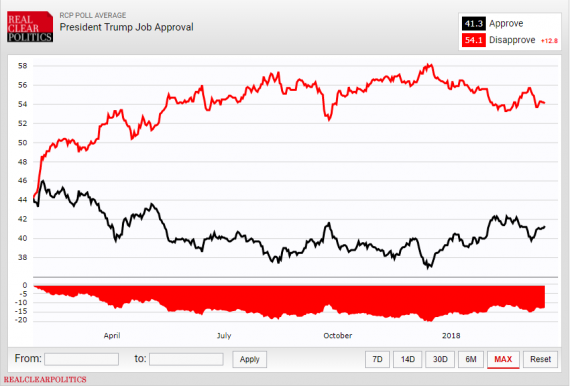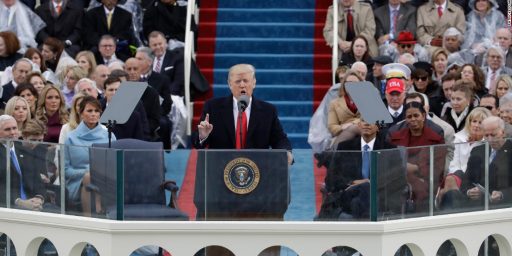2018 Continues To Look Good For Democrats
Things continue to look good for Democrats as we get closer to the midterm elections.
A new Generic Congressional Ballot poll from NBC News and The Wall Street Journal has more bad news for Republicans and good news for Democrats:
WASHINGTON — Democrats enjoy a 10-point advantage over Republicans in congressional preference for the 2018 midterm elections, even as President Donald Trump’s job approval rating has ticked up, the latest national NBC News/Wall Street Journal poll finds.
Fifty percent of registered voters say they prefer a Democratic-controlled Congress, while 40 percent want a GOP-controlled one.
That double-digit lead — typically a sign of strong Democratic performance for the upcoming election — is up from the party’s 6-point edge in January’s NBC/WSJ poll, which was 49 percent to 43 percent, though the change is within the poll’s margin of error.
The survey, which was conducted March 10-14, also shows Democrats holding the early enthusiasm advantage: Sixty percent of Democratic voters say they have a high degree of interest in the upcoming elections (registering either a “9” or “10” on a 10-point scale), versus 54 percent of Republicans who say the same thing. In addition, 64 percent of 2016 Clinton voters say they have a high level of interest, compared with 57 percent of 2016 Trump voter
Meanwhile, the NBC/WSJ polls finds that Trump’s approval rating stands at 43 percent among all Americans — up four points from January.
Fifty-three percent of adults say they disapprove of the president’s job, down from 57 percent two months ago.
The improvement for Trump comes from Republican respondents (who went from 78 percent approve in January to 84 percent this month), white men (52 percent to 59 percent) and independents (33 percent to 45 percent).
“Trumpism may well help Donald Trump in his 2020 election, but the buck stops there — which is a flashing red light for Republicans in 2017 or 2018,” says Democratic pollster Fred Yang, who conducted the poll with GOP pollster Bill McInturff.
Still, Trump’s overall approval rating at 43 percent is the lowest for any modern president at about 14 months into his job.
“Survey to survey, numbers bounce around. But today’s state of play continues to tell the same story — a president with lower than average job approval starting his second year with a Democratic edge in the midterms,” says McInturff, the Republican pollster.
Among the more interesting details in the poll is the fact that voters in Republican-held Congressional Districts are far less positive about the prospect of the GOP holding on to control of Congress than voters in Democratic-held Congressional Districts about their party winning control. As Chuck Todd explained during a segment of Meet The Press this morning, the results in the districts that the poll focused on found that the results on the Generic Congressional Ballot question in the Republican-held districts showed voters roughly equally divided on the question of which party should control Congress. In the Democratic-controlled districts, though, there was a clear majority in favor of Democrats winning back control of Congress. What this suggests is that the GOP has lost the support of a sizeable portion of the independent voters that it would need even in Republican-help districts to retain seats while Democrats are solidly in control in the seats they hold. This bodes well for Democratic fortunes in the fall.
Looking beyond the numbers in this one poll, the numbers continue to look good for Democrats in the poll averages. The RealClearPolitics average, for example, gives Democrats a 12.8% margin over the GOP with an average of 53% of respondents saying they would prefer a Democratic candidate and an average of 41.3% saying they would prefer a Republican. The Pollster average is somewhat more conservative in that is shows 42.6% of respondents saying they would support a Democrat and 36.0% saying they would support a Republican. Finally, the FiveThirtyEight projection shows 48.5% of respondents saying they would support a Democratic candidate and 38.5% saying they would support a Republican. These numbers are down somewhat from the heights they were at near the end of 2017, but they still show a strong preference among voters for a Democratic-controlled Congress. Additionally, as the chart from RealClearPolitics shows, the trend appears to be once again working in favor of the Democrats:
All of the usual caveats apply here, of course. We’re still over seven months away from the midterm elections, after all, and there’s any number of things that could happen between now and then that could have an impact on the elections themselves. Additionally, it’s worth keeping in mind that the General Congressional Ballot doesn’t always paint an accurate picture of what’s likely to happen in the 435 House elections and, as things stand now, 35 Senate elections (33 regular end-of-term elections and two Special Elections) that will take place in November. In reality, the fate of the House of Representatives will come down to the fate of, at most, a couple dozen seats where the Democrats may have a likely chance of winning against a Republican incumbent or in an open-seat race for a seat held by one of the many Republican House members who are retiring at the end of the current session of Congress. Since the Generic Congressional Ballot is a national poll it doesn’t really give us an accurate picture of what’s going on at the District level. We’ll be able to get some idea of where the Senate is headed as various polling companies begin focusing on the likely competitive races in that body, but the odds are that we won’t see much polling at the Congressional District level so, as is usually the case, we’ll be headed into the midterms somewhat blind about what the outcome could be. All that being said, the ground looks very good for Democrats right now, and that should have Republicans very worried.








tRump’s having a fucking meltdown on twitter today.
@steve story:
While not surprising, it’s beyond depressing to see the PotUS citing a partisan infotainment opinion program as “fact.” Not to mention perhaps the dumbest of the dumb show on Fox.
Yes, Obama went on the Daily Show. At no point can I remember him addressing the public and using John Stewart to justify a factual position.
On Oct. 23, 2010, little over a week before the midterm elections in which Republicans would go on to gain 63 seats, Daniel Larison wrote the following:
The fallacy here is that Larison was considering each House race in isolation and not considering the national mood. To a large extent, politics has become extremely nationalized in recent decades. That doesn’t mean things like candidate selection and local issues don’t matter, but they are only one among several factors, and they aren’t even necessarily the most important factor.
So I do actually think that the generic ballot is one of the most important polls to pay attention to–with a few caveats. First, as you mentioned there’s still time for conditions to change. I looked at RCP’s list of generic-ballot polls from 2010, and as late as June many were still showing Dems in the lead. Of course, conditions are just as likely to worsen for Republicans between now and November as they are to improve.
The other thing to keep in mind is that, based on the evidence of recent midterms, Dems need a larger national lead than Republicans in order to gain roughly the same number of seats, because the House has a Republican skew. (It is usually attributed to “gerrymandering,” but it is also a result of the concentration of Democratic voters in densely populated areas, a factor that predates the 2010 GOP-friendly redistrictings.) In 2006, Dems led 8 points nationally and gained 31 seats; in 2010, Republicans led just 6 points nationally and gained 63 seats. In 2012 Dems actually won a plurality of the national House vote but failed to capture a majority of the chamber.
Dems likely won’t be able to capture the chamber simply by leading the national vote; they probably will have to lead by a significant amount–at least 6 points I’d surmise. And the generic ballot itself is far from a perfect predictor of the national vote.
Nevertheless, with all these caveats in mind, the generic ballot is still the best indicator we have as to what will happen in November.
Just prosecute Errbody.
Aren’t congressional districts supposed to contain around the same number of people in each district? If that’s the case, how is gerrymandering not at fault for the Republican skew…
@An Interested Party:
Because it is a small (area wise) district packed with Democrats and you would get that without having to do some outlandish gerrymandering, you just have to draw four lines….
@An Interested Party:
That’s a good question, and it’s the exact one I had when I first heard about this problem. In fact I think it’s one of the main reasons this problem hasn’t gotten anywhere near the attention gerrymandering has. It’s somewhat counterintuitive–yet it may in fact be more important than gerrymandering (though much harder to remedy through electoral reform).
The answer is that it’s not so much about the population of each district, but rather about the comparative lack of advantage gained from scoring high percentages of the vote in urban areas. It’s analogous to the disadvantage that Hillary Clinton faced in the electoral college, where she was doing disproportionately well in states where those extra votes had no effect on her electoral score (from an electoral standpoint there’s no difference at all between a 30-point lead in California and a 2-point lead) and so were effectively wasted. Similarly, Democratic candidates in the House get a lot of extra votes in the urban districts where they’re heavily popular, which don’t actually translate into a greater number of seats.
For more on this, see the following 2014 article:
@PJ & Kylopod: Perhaps a partial answer to this problem will be seen in the fall in Pennsylvania…it will be interesting to see how many seats Democrats pick up in fairly drawn districts free of gerrymandering (well, certainly fairer than those drawn by the Republican-controlled state legislature)…
@An Interested Party:
“Perhaps a partial answer to this problem will be seen in the fall in Pennsylvania…it will be interesting to see how many seats Democrats pick up in fairly drawn districts free of gerrymandering (well, certainly fairer than those drawn by the Republican-controlled state legislature)…”
Democrats have roughly a 56 to 44 edge in two party voter registration in PA. “As of early fall 2016 registered Democrats outnumber Republicans by 919,000 in Pennsylvania, with 4.1 million Democrats and 3.2 million Republicans. 452,669 voters were registered with non-major parties and 702,482 defined themselves as non-affiliated.” Yet, almost no one expects they will get a majority of the 18 congressional districts, as that would suggest, with most observers expecting them to gain 3 seats through the new districts, leading to 8 D seats and 10 R seats, because Philadelphia (which is over 2 districts by itself) is over 80% registered Democrats.
@An Interested Party:
Five Thirty Eight did a short series of podcasts about it. They can be found here: Gerrymandering Project
@Moosebreath: That’s a good analysis, but I’d caution a little about reading too much into party registration. Kentucky, to this day, has a majority of registered Dems (though the gap has narrowed significantly in recent years) but has been solidly red at the federal level for the past two decades. The PA district where Conor Lamb just scored his upset win has had majority Dem registration despite voting overwhelmingly (up to now) for Republican Congressmen and Republican presidential candidates.
In a way, that’s the story of American politics over the past century. Southern and rural voters who once identified strongly with the Democratic Party have moved heavily into the Republican column over time. These are people who supported FDR in the 1930s. They included the nation’s farmers, a bloc that used to be solidly Democratic but which is now solidly Republican (creating the odd situation we have today in which it is the GOP that generally backs generous farm subsidies that are a holdover from the New Deal). Many of these voters will still register or self-identify as Democrats and may even back Democratic candidates at the local level, despite being effectively Republican when it comes to federal elections.
The urban/rural dichotomy has increased over time, and it’s part of what the article I linked to was talking about:
It is not only the House where the effects of this can be seen. It’s also responsible for that map which Trump loves to tout, showing the county-by-county breakdown of the 2016 election, which makes the country look like a giant sea of red with tiny blue dots here and there. That’s because those blue dots, while geographically small, are where the actual people are to be found.
Whether it concerns the House, the Senate, or the Electoral College, we live in a system that gives vastly disproportionate power to people who reside in more sparsely populated areas. This has been true for a long time, though it’s increased as the country has grown more urbanized, and it’s more polarized by party than ever, with the Republicans reaping nearly all the benefits.
@Moosebreath: While 8 Democrats and 10 Republicans doesn’t match the breakdown of the number of Democrats and Republicans in the state, it certainly is closer to that than the 5-13 Republican gerrymander…